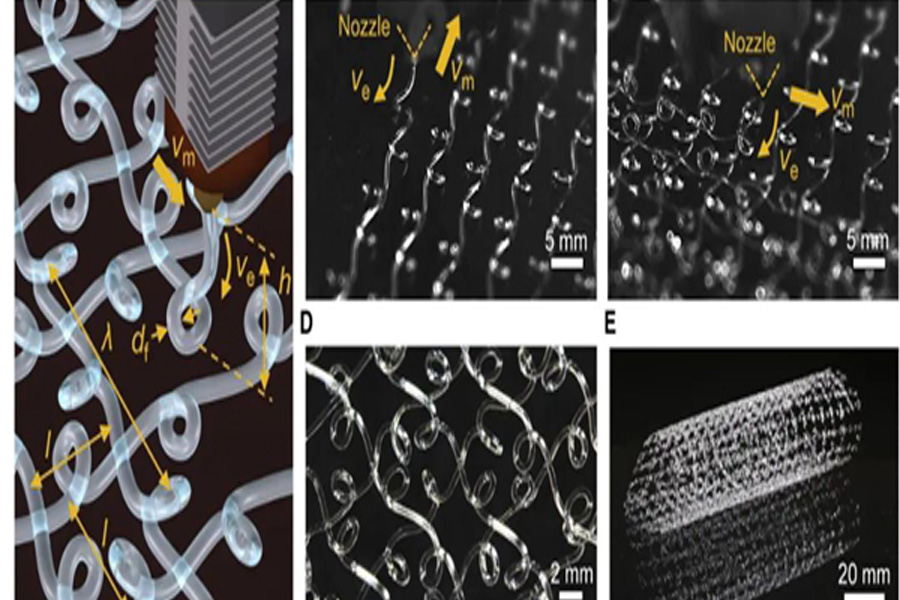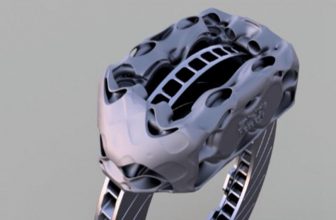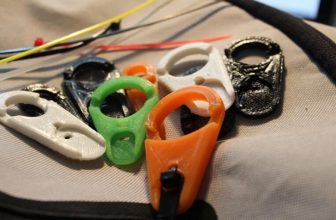
It is reported that many safety-critical engineering systems require transparent materials with high impact absorption. Existing transparent and tough composite materials have higher impact resistance, but due to poor impact absorption capacity, catastrophic failures often occur. A team from the Montreal Institute of Technology presented on “Cell Reports Physical Science” on October 28, 2020, a transparent impact-absorbing composite material that uses 3D printing technology to reproduce the sacrificial keys and concealment involved in spider silk The length of the toughening mechanism can absorb up to 95.6% of the impact energy without breaking. This innovation paved the way for the creation of an unbreakable plastic shell.
The beautiful sceneries of nature are often amazing and inspire us to be inspired. Inspiration from nature will prompt people to use the newly developed additive manufacturing technology to put it into practice. The beautiful scenes from nature, especially the ingenious structures in nature, not only refer to the natural structure with perfect curves and unique organic structure, but also refer to its unique functions and performance, even multi-functional performance. In the evolutionary process of about 3.8 billion years, the creatures in nature have gone through the process of natural selection to form a unique functional structure. This structure is determined by the organism itself or by the external environment. Learning from this structure of nature can optimize and improve the practical application effect in engineering, and even help us solve the problems encountered in actual engineering, and this is a sustainable solution.
Spider webs evolved from their weavers, and are used to dissipate the huge kinetic energy generated when prey is captured. Unlike other tough biological materials such as tendons, only 10% of the absorbed energy is dissipated, and 90% is stored as elastic energy in the material. As much as 70% of the energy absorbed by the spider web is dissipated outside the system. Spider webs dissipate energy mainly through the breaking of molecular bonds, the increase of entropy, and the internal heating of radial lines. Therefore, the elastic energy released during unloading is minimized to prevent insects from being ejected by the swinging net after impact. The energy dissipation in the radial lines is attributed to the silk fibril nanostructure, which is composed of β sheet-like nanocrystals and semi-amorphous domains (Figure 1A). After stretching, the breaking of hydrogen bonds and the unraveling of protein chains in the semi-amorphous domain contribute to greater scalability and high energy dissipation. This is the so-called sacrificial bonds and hidden lengths (SBHL) mechanism. This variation of energy dissipation mechanism has been successfully applied to hydrogels and elastomers, resulting in high hysteresis as high as 85%. Researchers are trying to expand this molecular-level mechanism on a microscopic scale to create a new type of impact-absorbing composite material that can absorb a lot of energy and capture projectiles like a spider web (Figure 1B).
A schematic diagram of a spider web catching flying prey. The high energy dissipation of spider webs is caused by β-sheet nanocrystals and semi-amorphous domains in the filamentous fibril nanostructure. The latter comprise highly extensible protein chains with intra-chain and inter-chain hydrogen bonds. Under the action of tension, the breaking of hydrogen bonds in the semi-amorphous domain unlocks the hidden part of the protein chain, thereby increasing the malleability and toughness of spider silk.
A transparent, shock-absorbing composite material inspired by spider webs can capture a free-falling baseball after five repeated shocks. The weight of the baseball is 0.5 kg, and it is dropped from a height of 0.66 meters from the falling dart impact tester. The images of the composite before and after the impact show the fracture of the sacrificial bond and the expansion of the hidden length, reproducing the energy dissipation mechanism of spider silk.
Inspired by spider webs, Professor Frédérick Gosselin, Professor Daniel Therriault and PhD student Shibo Zou of the Montreal Institute of Technology hope to show how to incorporate plastic webbing into a glass plate to prevent it from breaking during impact.
Bionics through 3D printing
Researchers use polycarbonate to achieve their goals. When heated, the polycarbonate becomes viscous like honey. Professor Gosselin’s team used a 3D printer to take advantage of this feature to “knit” a series of fibers with a thickness of less than 2 mm, and then quickly repeat the process by printing a series of new fibers vertically, and then move quickly until the entire web was cured.
When a 3D printer slowly extrudes it to form fibers, the molten plastic will eventually form a circle, which eventually forms a series of rings. The researcher Gosselin explained: “Once hardened, these loops become sacrificial connections, giving the fiber extra strength. When an impact occurs, these sacrificial connections absorb energy and break to maintain the overall integrity of the fiber, similar to Silk protein.”
▲Schematic diagram of composite material manufacturing process. The double-layer fabric composed of micro-structured polycarbonate fiber is manufactured by IFFF, and then is infiltrated with a transparent elastomer in a mold with an internal size of 100 × 100 × 1.5 mm (length × width × thickness). Two transparent elastomers with different refractive index values (1.41 and 1.55 at 589 nm) were used to make composite materials.
In an article published in 2015, Professor Gosselin’s team demonstrated the principles behind the manufacture of these fibers (as shown below).
The lead author of the study, Shibo Zou, took the opportunity to exemplify the behavior of this kind of net inside the protective screen. After embedding a series of fiber meshes in a transparent resin board, he conducted an impact test. How is the result? Plastic wafers can disperse up to 95.6% of the impact energy without breaking. They will not break, but deform in some places, thus maintaining the overall integrity of the wafer.
▲(G-J). (G) Elastomer film, (H) Straight fiber composite film, (I) Alternating fiber composite film and (J) Mixed fiber composite film at six different moments after the initial contact, the high speed of the impact test Camera snapshot (t = 0 ms). Because the stiffness is different between the four different specimens, so at the same instant, the dart appears in different positions of the four specimens. The displacement d is defined as the vertical displacement of the dart after the first contact, and is marked on each snapshot of each sample. Under the same impact energy (5 J), the impactor penetrates the elastomer film and the straight fiber composite film. The alternating fiber composite membrane and the hybrid fiber composite membrane capture the impactor by absorbing a large amount of energy. The release of elastic energy causes the dart to bounce back and produce the unloading curve shown in (B). (K-N) Optical images of (K) elastomeric film, (L) straight fiber composite film, (M) alternating fiber composite film and (N) hybrid fiber composite film broken after impact test. The scale bar in the illustration represents 10 mm.
According to Professor Gosselin, this nature-inspired innovation could lead to the creation of new types of bulletproof glass, or to the production of more durable plastic protective smartphone screens. Professor Gosselin pointed out: “It can also be used as a protective coating for aircraft engines in aerospace.” At the same time, he certainly intends to explore the possibilities that this method may open for him.





